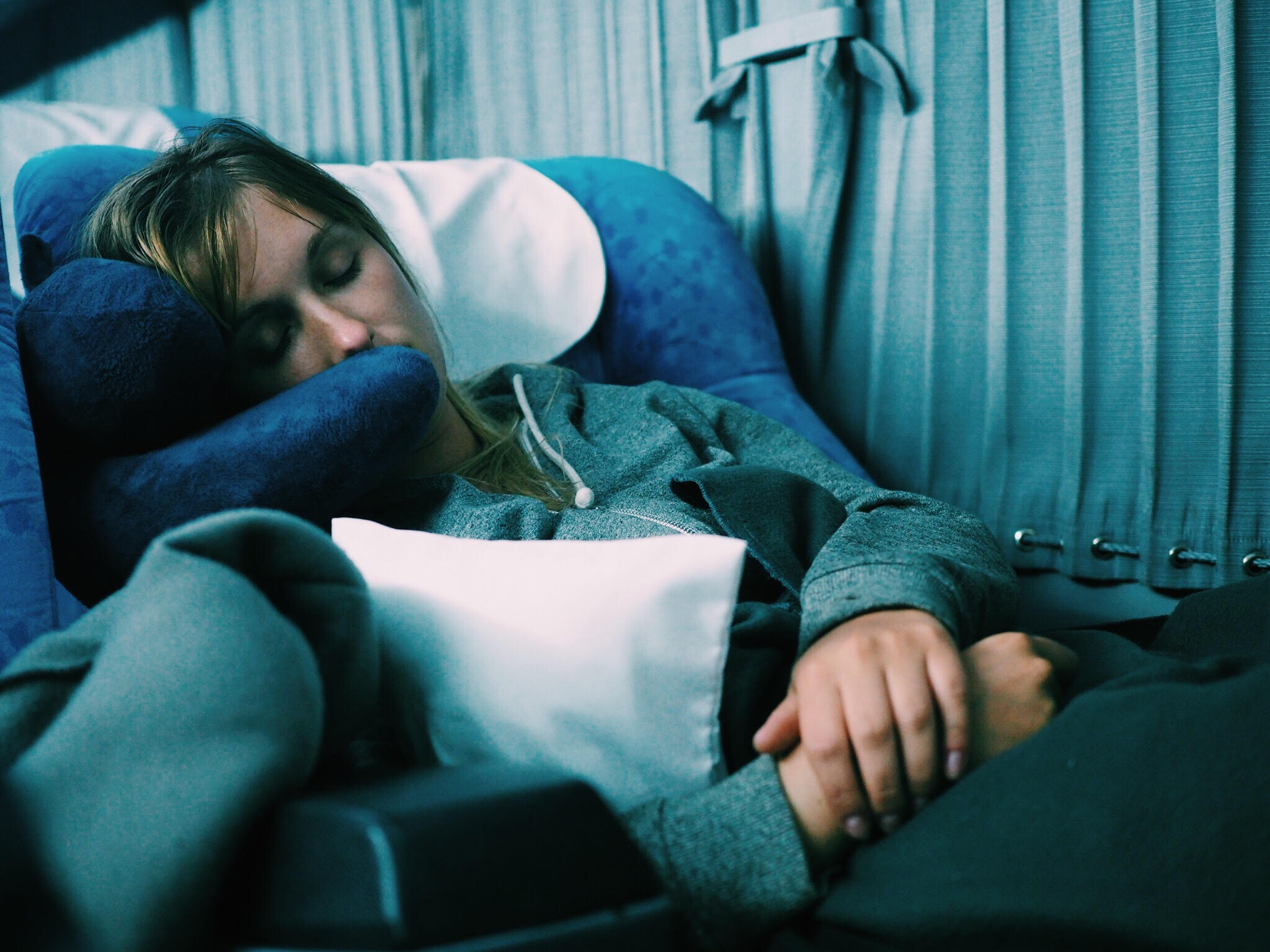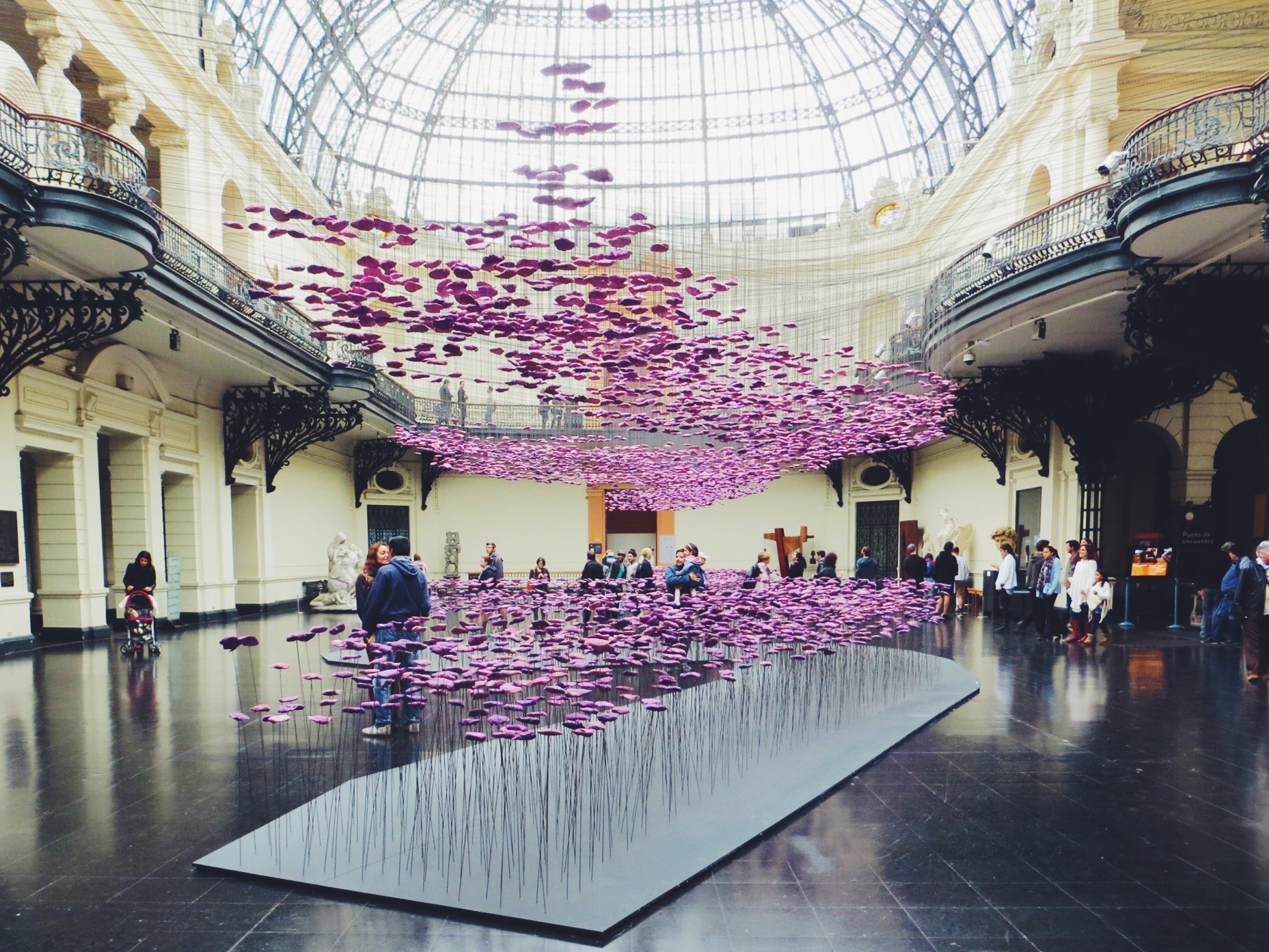Santiago and Valparaíso
After a 14 hour night bus we had left behind the landscapes of Patagonia and arrived in central Chile to visit a couple of cities that were on our travel list. First up was the capital city of Santiago, followed by Valparaíso, a small but charming city on the west coast. We had only done a little research on both, and so we're keeping an open mind, keen to see what the cities had to offer in terms of sights, culture and cuisine.
Santiago
We hadn’t been in a big city since Buenos Aires and so were excited to experience the buzz of the Chilean capital. As we only had 2 days, (and one of them was a Monday where a lot of things are closed in South America) we decided to visit the cities highly rated galleries while they were open. Our hostel Santiago Backpackers was centrally located, making it perfect to visit everything we wanted to in a short timeframe.
Galleries and Museums
Our first stop was Museo Nacional de Bellas Artes, a beautiful 19th century Beaux-arts style building home to Santiago's contemporary art scene. Luckily for us it was free entry to all exhibitions, and as we entered the main hall we were treated to a huge installation made out of suspended purple tissue paper. Making our way around the other exhibitions we came across a dark curtained room where Chilean artist Norton Maza’s dramatically lit installation depicting the rapture hung from the ceiling. We were very impressed with the variety and interest of each room in the Bellas Artes gallery, especially for a free exhibition.
The next cultural stop-off was the Museo Chileno de Arte Precolombino (Pre-columbian Art Museum). The museum had a fascinating collection of pre-columbian artefacts, categorised by the location of ancient civilisations of Central and South America including Mesoamerica, Isthmo-Colombian, Pan-Caribbean, Amazonia and the Andean regions. It was great to delve deeper into the ancient history of South America as we wandered around the beautifully presented exhibits.
From ceramics and masonry to beautifully intricate fabrics, it was really interesting to see such advanced techniques used so long ago. Also on display was an amazing configuration of threads called Quipu (or talking knots) that represented some kind of historical data using a series of knots and coloured strands, revealing the incredible sophistication of the ancient inca people.
Markets
We'd been advised by other travellers that the Tours 4 Tips walking tours were very worth while, so the following day we met our guide (dressed as Wheres Wally!) at 10am and made our way to the first of Santiago’s many famous food markets including Mercado Central and La Vega Central. We wandered round various fruit and vegetable stalls selling exotic fruits deemed too good to export.
Our guide explained the tight and often emotional relationships that occur between sellers and buyers, and how loyalty was an important part of market culture in Santiago. What we loved most was that people of all ages in Santiago met to haggle and bargain for the best fruit, veg and meat in the city, regardless of social class or privilege.
We decided to have lunch at the bustling Mercado Central with a few members of our tour group. It was packed with locals and heckling waitresses, and after choosing a place we were keen to try out the specialties including Machas a la Parmesana (Razor clams with cheese) and Pastel de Java (Chilean Crab Pie). Our waitress was a real character and recommended us local dishes and even smuggled us wine into Sprite bottles as she didn't strictly have a licence! There were big group hugs all round by the end of the meal and other than the razor clams - a required taste - we really enjoyed our traditional Chilean lunch experience.
Cementerio General de Santiago
Our next stop in the Tours 4 Tips route was the main cemetery in Santiago, Cementerio General. We weren't sure if it was going to feel underwhelming after visiting La Recoleta Cemetery in Buenos Aires, but in fact we found it even more interesting. Unlike Recoleta, Santiago’s main cemetery accommodates all social classes, using high-rise style buildings to house the less wealthy as well as grand and often over-the-top mausoleums to celebrate the rich and privileged. We were taken to the children's graves, including local child Saints, covered in flowers and toys. The final stop was the grave of the former president Salvador Allende where we were given a brief history lesson on Chile's turbulent and bloody politics in the 70's due to the rise in power of Augusto Pinochet.
We ended the tour in a bar where we were all offered a Terramoto, a Chilean cocktail consisting of sweet fermented wine and pineapple ice cream. It was definitely an interesting combination! Terramoto translates to earthquake in Spanish, and our guide explained that due to Santiago’s seismic location earthquakes were extremely common, and if we did experience one we were only to panic if the locals did!
Santa Lucía Hill
As the main viewpoint (Cerro San Cristobal) was closed due to maintenance we decided to walk to Santa Lucía Hill to take in the views of the city. On the way we picked up some amazing Gelato at Emporio La Rosa (obviously not as good as Nonnas) and made our way to the steps. Thinking it was just a view point, we were surprised to find a beautiful landscaped garden with crumbling buildings and walkways that snaked up the hill. From the top there was a decent view of the expansive city, and it was great to see the beautiful old Spanish colonial architecture dotted amongst the glassy skyscrapers.
Asian feasts in Santiago
We had experienced some amazing food in South America during our travels, but we had really started to crave Asian cuisine. As Santiago is a very multi-cultural city we thought we'd take advantage by visiting a couple of the Asian restaurants in the capital. Before our first meal we went for a quick drink at the W Hotel to get a view of the city by night. The Pisco Sours were massively over priced but the view was amazing, and it was great to see the scale of the city from such a height.
On our first night we decided to go to Rishtedar, a small but charming and well reviewed Indian restaurant located close to the El Golf Metro stop. We ordered up an Indian feast of popadoms, tikka masala, prawn curry and garlic naan; it was a real treat for the tastebuds after far too many empanadas and papas frittas!
On our second night we decided to visit another well reviewed restaurant called Vietnam Discovery for some more spicy flavours. The shabby entrance looked at home on the Kingsland Road in Hackney, but once in we were taken through a passage leading to an amazing Vietnamese themed oasis! The food and atmosphere was brilliant and even though not exactly a South American experience it was interesting to see that Asian food was just as popular in Santiago as it is in London.
Valparaíso
Only 1 hour from the capital, Valparaíso is a popular city to visit due to its colourful buildings and vibrant bohemian culture. We had done a bit of research prior to arrival and had learnt that Conception was the best area to stay. Filled with amazing street art, steep steps and cosy cafes and bars, the area was a perfect base for our 2 day visit.
Our hostel, Casa Volante, was located on the Fischer steps above a great bottle shop that sold regional craft beers. On our first night the hostel was hosting a small BBQ, so after a quick wander around the picturesque streets we took the chance to chill, drink local wine and beer and chat with other hostel guests about their travels.
The following day we were advised to take another Tours 4 Tips city tour. We had heard the afternoon session was more interesting, so after a leisurely lunch we met up with the tour guide in the central plaza at 2pm. We were taken to the docks where we were told about the historic importance of Valparaiso due to its ideal half-way location for cargo ship travelling between the Atlantic and Pacific oceans. After the opening of the Panama canal in the early 20th century, the port became more or less redundant. However, the city had become an UNESCO heritage site in 2003, allowing Valparaíso to retain its historic interest and charm. The colourful buildings and graffiti-clad walls with sunny ocean views made the city perfect for strolling around.
What we found particularly interesting was the impact that the port had on the architecture of Valparaíso. As we continued the tour up to Conception hill we noticed the all buildings were covered in colourful corrugated iron. We were told that this was due to the fact that cargo ships carried iron to add extra weight to their ships when sailing between the Atlantic and Pacific oceans, which was subsequently dumped in Valparaíso, making a perfect humidity-resistant material for covering their houses.
To prevent rust the iron sheets were painted with leftover boat paint, hence the bright colours. The tour was ended at a secret historic residence, where we were offered a Vino Pipeño (sweet wine) and were given the chance to ask additional questions about the city.
That evening we treated ourselves to a meal at La Conception, where we had pisco sours followed by amazing seafood dishes of crab ravioli and conger eel (a national delicacy) with a great view of the city. We then went to a small bar and drank Terremoto cocktails like locals! It was the perfect way to end our stay in Valparaiso, which although small had a lot of interest and culture; it had positioned itself as one of our favourite cities on our trip.
Santiago and Valparaiso were relatively short stop-offs on our travels up to the Atacama, but we loved the atmosphere and local culture of both cities. Santiago might not be as epic as Rio or charming as Buenos Aires, but it certainly made a lasting impression on us during our 2 days there. Valparaiso oozed charm and character, and was a great place to explore for a couple of days. From bustling food markets to amazing fresh fish, world-class galleries to colourful street art, our stay in both cities in central Chile had been short but very sweet.
















































